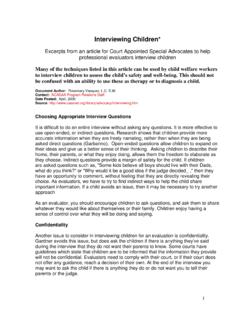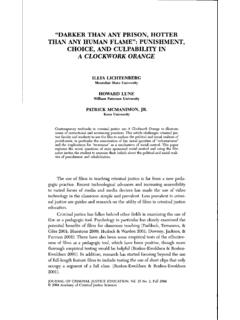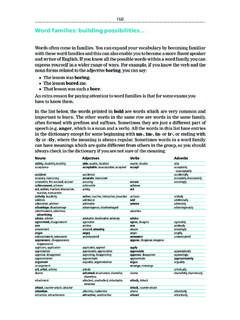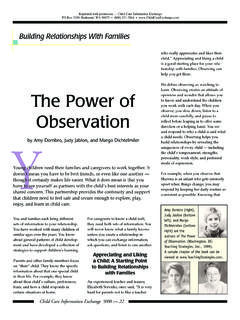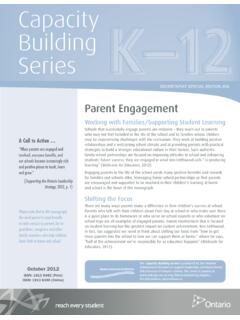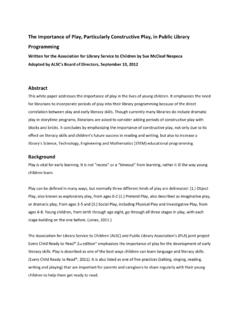Transcription of Achieving Permanence For Children In the Child Welfare ...
1 Achieving Permanence For Children In the Child Welfare system : pioneering possibilities amidst daunting challenges By Lorrie L. Lutz, MPP Consultant to The National Resource Center for Foster Care and Permanency Planning Hunter College School of Social Work A Service of the Children 's Bureau November 2003 Achieving Permanence For Children In the Foster Care system : pioneering possibilities amidst daunting challenges Permanence A MUST FOR Children 3 THE POLICY AND PRACTICE JOURNEY TO PERMANENCY 4 AN OVERVIEW OF THE Child AND FAMILY SERVICE REVIEW RESULTS AND THE MOST RECENT AFCARS DATA 7 A LOOK AT INNOVATIONS IN THE FIELD FOCUSED ON IMPROVING Permanence FOR Children 12 CONNECTICUT: COMPREHENSIVE ASSESSMENTS AND VISITATION CENTERS 15 SOUTH DAKOTA.
2 ENHANCED FOSTER PARENT- system INTERACTION 19 MISSISSIPPI: NO DECLINE/ NO DISMISS CONTRACT CLAUSE 20 VERMONT: SHINE THE SPOTLIGHT ON THE PROBLEM 22 GEORGIA: FIRST PLACEMENT BEST PLACEMENT 25 COLORADO: EXPEDITED PERMANENCY PLANNING 29 ARIZONA: A COMMUNITY RESPITE NETWORK 32 CALIFORNIA: KINSHIP CAREGIVERS SUPPORT 35 CONCLUSION 38 CONTACT LIST 39 APPENDICES 3 Achieving Permanency for Children .
3 pioneering possibilities amidst daunting challenges Permanence A MUST FOR Children Permanence the word brings to mind thoughts of When the word Permanence is integrated into Child Welfare policy language, it suggests long term and meaningful connections an attachment between a Child and a caring adult. We have learned through research and study of human development that to evolve into a psychologically healthy human being, a Child must have a relationship with at least one adult who is nurturing, protective, and fosters trust and security.
4 We also know that optimal Child development occurs when the spectrum of needs are consistently met over an extended period. When healthy attachment occurs, it forms the basis for all other long-term relationships between the Child and other persons. 1 We also know that having this connection with an adult who is devoted to and loves a Child unconditionally is key to helping a Child overcome the stress and trauma of abuse and neglect. However, the reality is that Children in foster care, who have been victims of abuse and neglect move a lot.
5 When this day-to-day consistency is lost, the emotional consequences of multiple placements or disruptions further impacts the Child s ability to trust and love. Repeated moves compound the adverse consequences that stress and inadequate parenting have on the Child 's development and ability to cope. Adults cope with impermanence by building on an accrued sense of self-reliance and by anticipating and planning for a time of greater constancy. Children , however, especially when young, have limited life experience on which to establish their sense of self.
6 In addition, their sense of time focuses exclusively on the present and precludes meaningful understanding of "temporary" versus "permanent" or anticipation of the future. For young Children , periods of weeks or months are not comprehensible. Disruption in either place or with a caregiver for even one day may be stressful. The younger the Child and the more extended the period of uncertainty or separation, the more detrimental it will be to the Child 's It has taken the Child Welfare system over three decades to fully comprehend and then implement key policy and practice reforms that emphasize Permanence as a fundamental requirement for the healthy development of a Child .
7 Let s consider the background and history of Child Welfare services commitment to permanency and how this history is impacting our success in Achieving permanent and stable placements. 1 Liebernan, , & Zeanah, (1995). Disorders of attachment in infancy. Infant Psychiatry 4 (3), 571-587. 2 Werner, , & Smith, (1982). Vulnerable but invincible: A longitudinal study of resilient Children and youth. New York: Adams, Bannister, Cox. 4 Achieving Permanency for Children : pioneering possibilities amidst daunting challenges THE POLICY AND PRACTICE JOURNEY TO PERMANENCY The past 30 years have seen major changes in how Child Welfare professionals think about the needs of Children and how Children should be served.
8 This evolution has resulted in refined definitions of best practice and a challenge to policy makers and practitioners to do a better job for Children . The Child Welfare system of the 1940s and 1950s primarily maintained Children in foster care or institutions. The Child advocacy movement that began in the 1960s and expanded in the 1970s fueled by the groundbreaking publication Children Without Homes3 had a tremendous impact on the field of Child Welfare , and awoke professionals, advocates and the public to the what was happening to Children in the Child Welfare system and specifically those residing in out of home care.
9 While many knew that temporary arrangements were not always good for the Children , it was not until this publication and other large scale research studies emerged that Child Welfare professionals had to face the stark reality that Children were drifting in care, and that these multiple moves had a devastating impact on a Child s long term emotional During this period in the history of Child Welfare in this country, the family centered movement was gaining support. Family centered practice spoke to the importance of working to maintain relationships with a Child and his/her biological family if possible, and if not possible, then to find a care situation as close in structure to a family as possible.
10 This commitment to family became embodied in the permanency planning movement. No Child is unadoptable became the call to When the landmark legislation 96-272 was enacted in 1980 it defined, for the first time in federal law, what best practice looked like in Child Welfare including placing family centered practice and the focus on Permanence at the center of sound Child Welfare practice. The core elements of practice as defined in 96-272 as synthesized by Ann Hartman included: Intensive in-home services to maintain Children in their homes and prevent placement.
